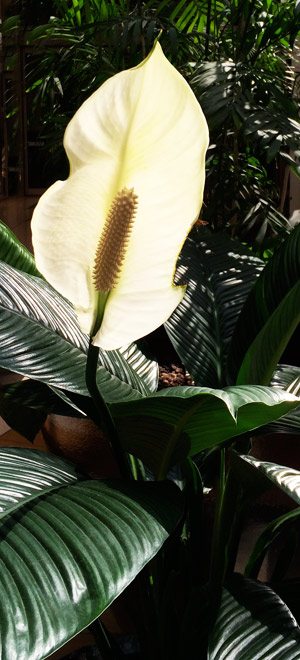
The Giant Peace Lily
If you ar looking for an indoor plant with large foliage and big showy flowers then the ‘Giant Spathiphyllum’ could be one to consider.
The botanical name of the giant peace lily is Spathiphyllum floribundum, and with flowers around three times the size of its little cousin it deserves common name as well.
Large handsome glossy ribbed foliage are an attraction throughout the year and Spathiphyllum floribundum is just as long flowering as the smaller plant in the right conditions. It does grow well indoors and with a little care will be fairly easy to grow.
This is a species that has been hybridised with others, including Spathiphyllum wallsii, and you will find cultivars with names like ‘Sensation’, ‘Mauna Loa’ that may well have been a result of breeding with Spathiphyllum floribundum. Other large leafed species include Spathiphyllum commutatum from Mayaysia through to the Solomon Islands and Spathiphyllum cochlearispathum from Mexico.
Like all Spathiphyllum this is a rainforest plant, it like good strong indirect light and a very open free draining soil yet with good moisture, these are the care factors.
Care
Best in a humid tropical climate and in good filtered light Spathiphyllum floribundum grows well outdoors in Queensland, however it is also a star performer in shopping centers across Australia. The trick to growing these plants successfully is providing an open potting mix as they take up oxygen through the root system as well as the foliage.
- Excellent in a pot or container as long as the soil is moist, well drained, open and humus rich.
- Indirect light yet bright.
- Best repotted every 2 -3 years and the foliage can be wiped over with a damp cloth to remove dust build up indoors.
- Best watered from below so the foliage does not get wet and damaged, especially indoors. Use tank water or let tap water sit for a day so any chlorine can burn off.
- Fertilize with a general slow release type every 3 months.
Spathiphyllum floribundum is not readily available for sale in Australia, although it and its large leafed hybrid relatives are offered for hire by a number of plant hire companies.
For constant flowering try maintaining these conditions.
- High humidity.
- Constant moisture.
- Well drained soil.
- No direct sun yet good bright filtered light.
Resources
